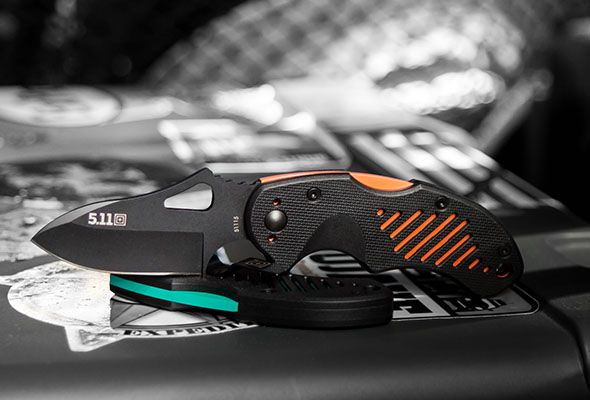How to Clean Your Tactical Knife
You don't have to clean your tactical knife every day, but like most of your other gear, you need to clean it after every use and do a little maintenance cleaning every few months if you haven't been using it. Dirt and grime stuck in a folding knife's pivot and locks can stop it from opening or closing properly, or from locking in the open or closed position. Grunge on a folding or fixed-blade knife can lead to corrosion, rust andpitting, which degrade its strength and reliability.

What You Need to Clean a Tactical Knife
Cleaning your tactical knife often means that you don't have to scrape away grimy buildup or scour away rust. Grab these supplies to clean your knife after you've used it in the field, at the range, in the outdoors or at home:
- Compressed air
- Cotton swabs
- Lubricant
- Masking tape
- Mild soap
- Rubbing alcohol
- Rust remover
- Sponge
- Toothbrush
- Towel
- Warm water
- White vinegar, baking soda or lemon juice and salt for rust
Use cleaning solvents only when you need to, and even then, avoid solvents made with chlorine, which can speed up corrosion. Good alternatives include acetone, MEK and paint thinner.
Pro Tip:If you use a cleaning solvent, read the label to make sure it won't damage the materials on your tactical knife's handle either.
How to Clean a Folding Tactical Knife
Heavily soiled knives (read: the knife you took on that hunting trip and didn't clean for a week) require more in-depth cleaning than those you only use occasionally around the house or in emergencies.
Note: This guide assumes you're leaving your knife assembled. To get a true deep-clean on a folding knife, you may have to disassemble and scrub it thoroughly.
- Before you start cleaning your folding knife, use masking tape to tape off the blade's edge. Your hands and your knife are going to get slippery, so this small safety precaution can go a long way toward keeping you out of the ER.
- Use compressed air to blow out loose dirt and debris around the folding knife, paying special attention to the pivot and locks.
- Wash the blade and handle with a sponge dipped in hot, soapy water. Rinse thoroughly and repeat if necessary.
- Scrub inside the pivot and the locking mechanisms with a clean toothbrush dipped in warm, soapy water. Rinse under moderate-pressure running water.
- Use a cotton swab to wipe down the inside of the handle, pivot andlocks. Move the blade to different angles as you swab. Be gentle, because cotton swab fibers can get caught in and disengage springs. If that happens, you'll have to take the knife apart to re-engage it.
- Dip the cotton swab in rubbing alcohol or a cleaning solvent if there's still dirt inside the pivot or locking mechanisms. Swipe the swab around the blade while it's set at various angles so you don't miss any grime.
- Use compressed air to dry the inner mechanisms.
- Wait until the knife is completely dry before lubricating. Even if you're using compressed air, you should wait at least 30 minutes before you lubricate your tactical knife.
How to Clean a Fixed-Blade Tactical Knife
- Tape off the blade's edge with masking tape. You can clean the edge separately when the handle is dry and easy to hold.
- Use a soft sponge dipped in hot water to clean the top of the blade and the handle. You can also soak the blade in hot, soapy water. Take care to keep the handle out of the water if the materials are porous, like wood.
- If you see built-up dirt or grime, use a toothbrush to remove it.
- Dry the blade with a clean towel or cloth.
How to Clean Rust off Metal
If your knife has rusted, use white vinegar, baking soda or lemon juice to remove it.
- White vinegar:Wrap the rusted area in a cloth soaked in white vinegar overnight or soak the metal in a cup, keeping the handle out if it's porous. Scrub rust patches with a soft-bristle brush.
- Baking soda:Make a paste from baking soda and water. Apply the paste to the rusted area and let it sit for several hours. Use a toothbrush to scrub it off. Then, clean as described above.
- Lemon juice and salt:Mix lemon juice and salt, then wrap the rusted area in a cloth soaked with the mixture. You can also immerse the blade in the mixture. Soak for several hours, then scrub the rust away with a soft-bristle brush.
Pro Tips for Keeping Your Tactical Knife in Good Shape
- Don't store your tactical knife in a sheath, which lets moisture build up (even in the desert) and may cause pitting and rust.
- Clean your knife after every use, and do a light cleaning every few months if you haven't used it in a while.
- Let your knife air-dry after washing. If you can leave it overnight, go for it.
- Always lubricate your knife after cleaning it. Use a lightweight formula and apply it to all the moving parts. Put a thin coat on the blade's surface, too, to prevent oxidation and corrosion.
Cleaning your tactical knife is the only way to protect your investment, whether you're using it every day or only occasionally.